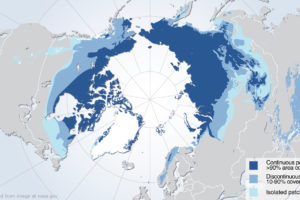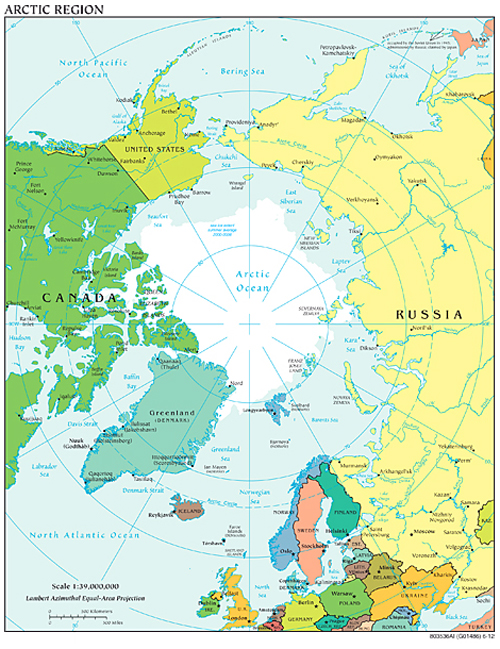As Russia Touts Expanded Arctic Sea Routes, U.S. Observers See Veiled Threat

(Voice of America – Danila Galperovich – WASHINGTON, April 15, 2019 – voanews.com/a/as-russia-touts-expanded-arctic-sea-routes-us-observers-see-veiled-threat/4875843.html)
This story originated in VOA’s Russian Service.
At this year’s International Arctic Forum in St. Petersburg, Russian leaders made the most peaceable statements to date about Moscow’s long-term plans for the a rapidly melting Arctic.
Answering questions during the forum’s international plenary session, President Vladimir Putin extolled Moscow and Washington’s common interests in the region, explaining that he doesn’t sense any “special military tension” in the region.
Not only does Russia forego military exercises in the Arctic, it’s focused on helping neighbors dramatically increase cargo shipments across Arctic sea routes, he explained.
“Our aviation activity in the Baltic Sea zone, the Arctic, is an order of magnitude lower than the activity of the NATO countries,” he announced to those in attendance, which included the leaders of Finland, Iceland, Norway and Sweden.
“This is a realistic, well-calculated and concrete task. We need to make the Northern sea route safe and commercially feasible,” Putin added.
Some activities omitted
 But Putin’s account of an ambitious commercial program to secure an Arctic foothold, which includes the planned construction of ports, infrastructure and even an expanded fleet of icebreakers, omitted the following activities.
But Putin’s account of an ambitious commercial program to secure an Arctic foothold, which includes the planned construction of ports, infrastructure and even an expanded fleet of icebreakers, omitted the following activities.
May 2017: At Moscow’s annual Victory Day parade, Russia unveils new weapons system with missiles outfitted for use in the Arctic.
October 2017: Arctic detachment of Russian Navy Northern Fleet combat ships practice live-fire missile drills.
February 2018: Admiral Nikolai Yevmenov, commander of the Northern Fleet, declares the strengthening of Russia’s Arctic military presence with the placement of tactical unit outposts. “This is an Arctic-motorized rifle brigade, a tactical group of coastal troops, air defense units that maintain a watch on the islands of the Arctic Ocean, in the archipelagoes of Franz Josef Land, Novaya Zemlya, Severnaya Zemlya and the New Siberian Islands.”
March 2018: “Putin,” a newly released campaign-trail film, shows the president boasting of Arctic-based, state-of-the-art missile-launch detection and tracking systems. “The Arctic region is extremely important for Russia,” Putin is recorded saying, and that U.S. submarines “keep constant watch in the Norwegian Sea off the coast of Norway.”
April 2018: Rosgvardia, Russia’s National Guard, conducts transport and assault exercises on the militarily inhabited Franz Josef Land.
September 2018: Colonel General Oleg Salyukov, commander of the Russia’s ground forces, announces a new generation “Tor-M2” air-defense missile system for use in the Arctic, and he says that the Bastion-P mobile anti-ship and surface-to-surface missile defense systems have already been placed on Kotelny Island.
February 2019: Pro-Kremlin Izvestia newspaper reports on Russian plans for MiG-31 fighter jet patrols of the Arctic, with two squadrons based at the Murmansk region aerodrome and plans for a permanently stationed regiment.
US voices: Arctic strategy needs update
Some U.S. military officials and legislators have expressed concern that Washington isn’t paying enough attention to Russia’s military entrenchment in the region.
They say the Department of Defense Arctic Strategy, last updated in 2017, largely got overlooked in the more all-encompassing National Defense Strategy, the main U.S. military strategy document signed by the chairman of the Joint Chiefs of Staff.
In August 2018, Congress passed a National Defense Authorization Act that approved unprecedented funds for the construction of six new polar class icebreakers by 2029. The U.S. Coast Guard has only two — one of which is 10 years beyond its intended use — compared to Russia’s 46.
The bill also calls for an updated Arctic strategy, including regularly updated summaries of regional foreign threats posed by Russia and China, along with specific roles and missions for each branch of the U.S. military.
According to one expert, the asymmetry of U.S. and Russian assets in the Arctic may have to do with how Russia sees itself and the resources it needs for long-term planning.
“The Arctic is extremely important for Russia, because it’s really part of their national identity,” said Robert Orttung of the George Washington University Elliott School of International Affairs. “In contrast to the United States, Russia really is an Arctic country. Much of the territory is in the Arctic, whereas in the U.S., it’s simply Alaska, so we don’t really think of ourselves as an Arctic country.
“I think the most important question for Russia is the energy there, because they depend heavily on the resources,” he added. “And going forward, that’s going to be the main source of oil and gas for the country. Second, of course, is defense, and they see that as the main way to build up their Arctic resources and to protect themselves against what they see as a potential threat coming from the north.”
Orttung also says the melting ice has drained the region of its historically romantic mystique, and that easier access to natural resources may open up more possibilities for international trade and cooperation.
“In the past, the Arctic was an area that people were extremely interested in, and there were these heroic explorers who really stirred the imagination in Russia and in the West,” he said. “Of course, that’s kind of changed now. Now the Arctic is seen more as a place of climate change and dramatic changes — and possibilities — in terms of trade and energy development.”
Military dominant situation
But the ultimate Russian goal is to have a militarily dominant situation in the Arctic, “especially at a time when the U.S. is perceived as an adversary,” he added.
“And the U.S. has been spending less money on the Arctic, but I think we have to look at the difference between the rhetoric coming from the Kremlin and President Putin, and the actual development on the ground,” he said. “I think [Putin] talks a better game than actually exists, and it’s more about presenting the face of developing this military capacity, when in fact there aren’t the funds in Russia to actually do that.”
Orttung also says he sees the Arctic as one of the last areas for prospective cooperation.
“The Arctic for Russia and the U.S. in particular is one of the last areas of actual cooperation, where we can work together as a citizen, as scientists, as observers,” he said. “So far, it hasn’t been infected by the difficulty of Russia’s invasion and occupation of Ukraine, for example. That’s sort of been kept as a separate issue. So all this increased talk about militarization — and of course, the U.S. is putting more airplanes and fighter planes in Alaska — and it’s just making it more and more difficult to see how the traditional cooperation that we’ve had in the Arctic can be preserved in the future.”
Retired Admiral Gary Roughead, former chief of U.S. Naval Operations, told VOA’s Russian Service that Russia, like any country, has a primary interest in protecting and defending its coastal borders, and that it has a geopolitical interest in influencing how sea routes are developed and used.
“To see the transpolar routes become more accessible and used … I think that it adds stature to Russia, and particularly to Putin, to begin to identify as being the premier, most powerful Arctic nation by virtue of what it’s doing from a military perspective,” he said.
While he’s no longer directly engaged in U.S. military strategic investments, Roughead said U.S. and European allies should enhance communications and transnational infrastructure for cooperative naval and aerial patrols with conventional and unmanned vessels.
“Something that we looked at was the ability to use unmanned aircraft to be able to patrol in the Arctic, because of their long endurance,” he said. “And that’s something that not only the United States should look at, but Canada and the some of the European Arctic nations to begin to put in place, some cooperatives, activities, perhaps cooperative investments, cooperative operations that allow us to operate up in the high north, routinely, reliably and safely.
“For example, unmanned airplanes being able to take off in one country, conduct the patrol and then land in another country,” he said. “Just having the infrastructure in place to do that — that’s something Arctic nations should strive toward.”
Twenty percent of Russia’s gross domestic product is drawn from the Arctic via mining and shipping, whereas less than 1% of U.S. GDP is taken from the region.
In 2013, the U.S. and Russian signed the Arctic Council’s “Agreement on Cooperation on Marine Oil Pollution Preparedness and Response in the Arctic,” which aims to improve U.S.-Russia collaboration on research in the environmental sciences, biology, ecology and shipping in the region.
